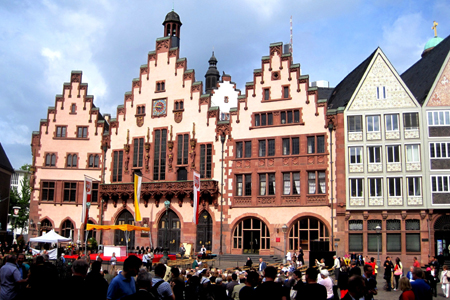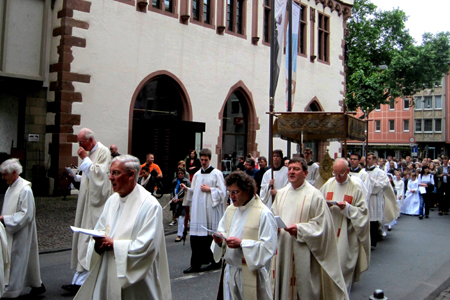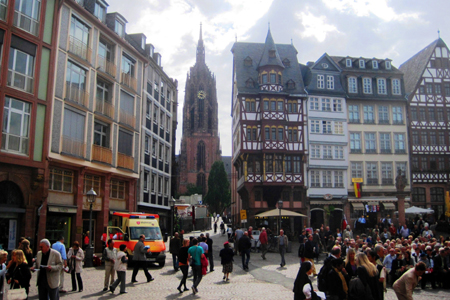| |
 |
 |
 |
| Comment on this report, or find other reports. |
 |
| Our Mystery Worshippers are volunteers who warm church pews for us around the world. If you'd like to become a Mystery Worshipper, start here. |
 |
| Find out how to reproduce this report in your church magazine or website. |
|
|
| 2392: City
Hall Plaza and Cathedral, Frankfurt am Main, Germany |
 |
 |
 |
Mystery
Worshipper: Portola.
The church:
City Hall Plaza and Cathedral, Frankfurt am Main, Germany.
Denomination:
Roman Catholic,
Diocese
of Limburg,
Pastoral District of Mid-Frankfurt. The pastoral district
is made up of the inner city parishes of St Bartholomäus, St
Leonhard, Allerheiligen, St Bernhard, Liebfrauen, St Ignatius
and St Antonius.
The building:
Two buildings were involved: The city hall (Römer), which was
the backdrop for the open-air service; and the cathedral, officially
the Imperial Cathedral of St Bartholomew. The Römer has been
the city hall for the last 600 years and consists of nine houses
connected by a neo-Gothic façade and balcony. The balcony
is often used as a stage for state visits and sporting events.
One of the rooms, the Kaisersaal (Emperor Hall), is a major
tourist attraction. The cathedral (the title is an honorary
one, since the bishop's seat is not here) was built in the 14th
and 15th centuries on the foundation of an earlier church. From
1356 onwards, emperors of the Holy Roman Empire were elected
in this church, and from 1562 to 1792, emperors-elect were crowned
here. During the Second World War the inner city of Frankfurt
was devastated by bombing. Both the cathedral and the Römer
were heavily damaged but were reconstructed after the war.
The church:
The pastoral district scheme, not immediately popular with clergy
or parishioners, was devised to help congregations work together
and share resources in order to compensate for the declining
number of priests, members and funds. It is not merely a defensive
strategy, but also an attempt to regain the initiative and become
more effective in outreach and ministering to the city. A priest
has to learn to be an efficient manager; he has severely limited
time for personal contacts with parishioners and has to serve
several churches. On the other hand, the shortage of priests
leads to a more active role for the laity. The Stadtdekan (Dean),
the Revd Dr Johannes zu Eltz, is responsible for the 150,000
Catholics in Frankfurt.
The neighbourhood:
The Römerberg, which is the name of the plaza in front of the
city hall, has been referred to as the "living room"
(gute Stube) of Frankfurt. Here, in 1933, Nazi students burned
the books of authors of whom the Fascist regime did not approve.
After the war, the Römerberg became a popular place for open-air
events, political demonstrations, festivals, etc. The oldest
Christmas market in Germany, established in 1393, is set up
here each year. When US President John F. Kennedy visited Frankfurt
in 1963, he spoke to 150,000 people in the wide-open space that
the heavy bombing of World War II had created at this spot.
In the 1980s the houses that had formerly stood on the east
side of the plaza were reconstructed, restoring the historical
shape and size of the Römerberg.
The cast:
Stadtdekan Johannes zu Eltz was the principal celebrant and
preacher. He was assisted by 15 priests (if I counted correctly)
who spoke the words of institution simultaneously and distributed
the eucharist among the congregation. Music was provided by
Collegium Vocale Liebfrauen plus wind instrument ensemble and
keyboard, directed by the district cantor, Peter Reulein. The
organist in the cathedral was Andreas Boltz.
The date & time:
Feast of Corpus Christi, Thursday, 7 June 2012, 10.00am.
What was the name of the service?
Festive Service on Corpus Christi with Procession and Benediction.
How full was the building?
The Römerberg was almost full. My guess is that at least 2000
people attended the open-air service. There was picnic bench
seating for about 300, with about 100 additional reserved bench
seats. The cathedral was overflowing – the seats were all
taken and the aisles were packed in a way that the fire department
would not have allowed had they known about it. I was trapped
in a side aisle and could not see the entire congregation, so
I can make no exact count of the size. In the state of Hesse,
Corpus Christi is a public holiday, which allows the Catholic
Church to hold well-attended services on this date.
Did anyone welcome you
personally?
No personal welcome. People handing out the worship programs did so silently.
Was your pew comfortable?
My standing place in the Römerberg was comfortable; I had room
to move my elbows. I was expecting to bake in the sun or be
drenched in a downpour (the usual options of a German summer),
but the weather was pleasantly mild. By contrast, my standing
place in the cathedral was not comfortable.
How would you describe
the pre-service atmosphere?
Stunning. At 9.45 the enormous Gloriosa bell of the cathedral
started ringing. This bell, which in the days before electric
mechanization allegedly required 18 people to get it ringing,
produces a deep, solemn, spine-tingling sound, as though it
were ushering in the Last Judgment. (On quiet Christmas Eve
nights I have heard this bell clearly from a distance of two
miles.) Five minutes later the other bells joined in. The air
seemed to be vibrating. Just before the service started, there
was a long and colourful procession of representatives of Catholic
organizations and orders, including young girls in their white
first-communion dresses and about 16 priests.
What were the exact opening words of the
service?
"In the name of the Father, and of the Son, and of the
Holy Spirit."
What books did the congregation use during the
service?
A printed program provided the words and musical notes for the liturgical singing and the hymns.
What musical instruments were played?
Wind instruments and keyboard at the open-air service. After
the procession, the cathedral organ.
Did anything distract you?
There was one distraction after another: pedestrians passing
by, the aroma of cooking from a nearby restaurant, the fervent
clapping of tourists showing their appreciation, and even a
light rainfall at one point. I was probably a distraction to
the other worshippers because of my note-taking and my moving
around to get the best angle for a photo. I must say that this
Catholic congregation was more disciplined and, thus, provided
fewer distractions than the Protestant congregation assembled
at this same place for an open-air service ten days previously
on Pentecost Monday.

Was the worship stiff-upper-lip, happy clappy, or
what?
The service was formal and festive, but not solemn or stiff.
The readings and prayers were in several languages. Some parts
of the service were in Latin. The opening hymn, the well-known
"Praise to the Lord, the Almighty" was sung simultaneously
in German, English, Czech, Slovene, Italian, French and Spanish.
Exactly how long was the sermon?
8 minutes.
On a scale of 1-10, how
good was the preacher?
7 – The Stadtdekan spoke lucidly and concisely and was
easy to listen to. He said that "false shepherds are as
strong as Rambo, as good-looking as Brad Pitt, as charitable
as Bill Gates." He also said that "they know the Bible
and theology as well as ..." but here he broke off, not
wanting to name any well-known theologian, which produced cheerful
laughter within the congregation.
In a nutshell, what was
the sermon about?
The focal point of the sermon was the opening words of a Corpus
Christi hymn (sung later): "Your Saviour, your Teacher,
your Shepherd and Nourisher." The preacher contrasted false
shepherds, who are antichrists, from the one True Shepherd.
False shepherds are deceptively attractive, but ultimately they
enslave their followers and drive them into fear and loneliness.
The True Shepherd speaks to our hearts, because our hearts were
created for him. Because we are not only spirit, he gives us
food from heaven for our bodies. The false shepherds feed upon
their flock so that they can live; the True Shepherd gives himself
as food for his followers so that they may live.
Which part of the service
was like being in heaven?
I do not like open-air services because I always feel like a
distracted spectator. But for the first time in my life –
despite the fact that I am a Protestant – I was really
involved and able to participate with heartfelt concentration.
Maybe it had to do with the concentrated attention of the massive
congregation that surrounded me. Some services convey the message
"It's all about us." The liturgical discipline of
this service subtly conveyed the heavenly message "It’s
all about worshipping God."
And which part was like
being in... er... the other place?
The conclusion of this service was in the cathedral. We were
packed in like sardines in a tin can, so that I felt trapped
and claustrophobic. But the real descent into the abyss occurred
at the organ postlude, Olivier Messiaen’s Livre du Saint-Sacrement.
There is probably no music in the "other place" but
if there is, then undoubtedly the Prince of Darkness would enjoy
this postlude. To my untrained ear it evoked feelings of chaos,
terror, disintegration, being hopelessly lost.
What happened when you hung around after the service looking lost?
In the mob scene inside and outside the church there was no possibility of anyone taking notice of a single person looking lost.
How would you describe the after-service
coffee?
Outside the cathedral there were stands offering a wide variety
of foods, drinks and information. There were picnic tables and
benches. It looked inviting and colourful.
How would you feel about making this church your regular (where 10 = ecstatic, 0 = terminal)?
2 – This service was an exception, as it involved several
congregations. However, as a Protestant, I know that I am not
invited to the eucharist in a Roman Catholic church. I realise
that there is precise and thorough reasoning behind every doctrine,
and I wouldn't want the Church to give up its unique identity
for the sake of a superficial communion fellowship with Protestants.
But I could never feel at home in a Catholic church.
Did the service make you feel glad to be a
Christian?
That's a good question, since this service reminded me of the
gap between Catholics and Protestants. The sacred host, which
was displayed in the monstrance and which was at the heart of
the Corpus Christi procession, was referred to more than once
as the "Allerheiligste", which corresponds to the
English term "Holy of Holies", the sanctuary in the
Jerusalem temple that was regarded as God's dwelling place.
I do believe in the real presence of Christ in the eucharistic
bread and wine, but as a Protestant I cannot refer to a consecrated
host as the Holy of Holies. But the schism between Catholics
and Protestants is, in my opinion, something positive because
it keeps us from becoming complacent. As long as there are schisms,
the uncompromising search for unity in truth should never cease.
So in this sense the service made me glad to be a Christian.

What one thing will you remember about all this in seven days' time?
Being in a Roman Catholic open-air service, celebrating a doctrine
that I cannot embrace. I should have felt like a foreign body
and should have been coldly detached. Amazingly, I felt entirely
at home and enjoyed the service thoroughly – until the procession
began and I realized that I could not march in a procession
honouring a doctrine I did not believe, and so had to withdraw
from the marching congregation. |
|
|
 |
 |
 |
| We rely on voluntary donations to stay online. If you're a regular visitor to Ship of Fools, please consider supporting us. |
 |
 |
 |
| The Mystery Pilgrim |
 |
| One of our most seasoned reporters makes the Camino pilgrimage to Santiago de Compostela in Spain. Read here. |
 |
 |
 |
| London churches |
 |
| Read reports from 70 London churches, visited by a small army of Mystery Worshippers on one single Sunday. Read here. |
| |
|
|
|
|


